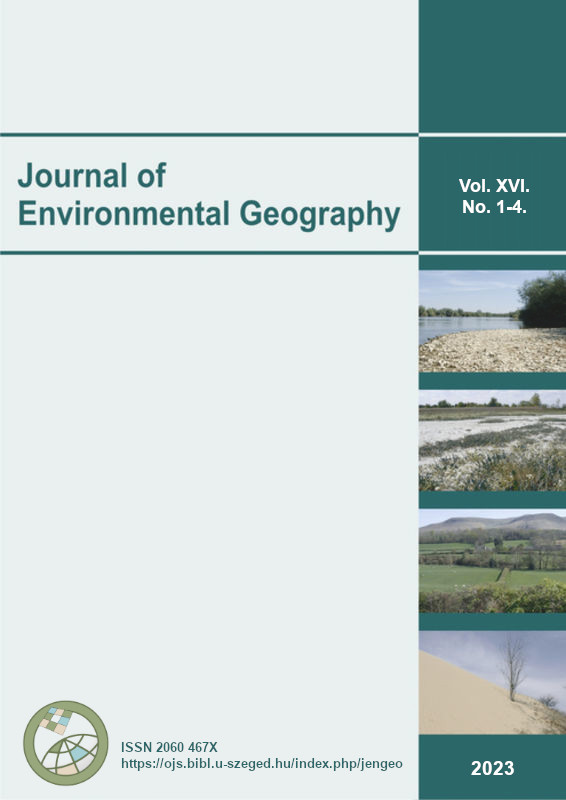Relationship Between Landscape Management, Land Use and Ecological Network in Nagykörű
Main Article Content
Abstract
In the summer of 2022, we experienced an extreme water shortage in the Great Hungarian Plain and the consequences influenced and still influence our lives in several ways. The long-term solution to the problem of drought is sustainable landscape management, which builds on the natural characteristics of the area – climate, soil, topography, hydrographic conditions and opportunities. The ecological network can provide a suitable framework for this concept, since the original idea intended to create balance between intensive and extensive land use. Our goal was to define the focus areas where the current cultivation is in conflict with the features of the landscape, and we identified the areas where it is necessary to change the cultivation method and those where other water retention proposals can gain space, thus ensuring water even in drier periods. The resulting land use will be in line with the water cycle, thereby increasing the area's resilience against drought. In our research, we chose the municipality of Nagykörű and its surroundings along the Tisza River as our study area, which - like the rest of the Great Plain - was hit by an exceptionally severe drought in the summer of 2022. On the 90 km2 research area, after fieldwork, we performed various GIS analyses. Based on these we examined the possibilities and suitability of the cultivation methods in the given area and worded our proposals. In the course of our research, we consulted with water management experts and local farmers in order to get a more accurate picture of the area's features, problems, and the feasibility of our proposals. The landscape architecture master students of MATE also helped us in preparing the analyses. The results showed that currently a significant part of the area is not managed in accordance with the geographical conditions. The deeper fields in the middle of the area, which currently are under intensive farming, would belo9ng, under natural conditions to the floodplain of the river Tisza. Here the extensive cultivation methods, such as orchards, gardens, or meadows are recommended. At the same time, the flood-free parts of the sample area are suitable for agriculture. If water retention strategies are used in the suitable areas, these will be more protected against the effects of drought.
Downloads
Article Details

This work is licensed under a Creative Commons Attribution-NonCommercial-NoDerivatives 4.0 International License.
x
References
Báldi, A. 1998. Az ökológiai hálózatok elmélete: iránymutató a védett területek és ökológiai folyosók tervezéséhez. Állatani Közlemények 83, 29–40.
Bennett, G., Mulongoy, K.J. 2006. Review of Experience with Ecological Networks, Corridors and Buffer Zones. Secretariat of the Convention on Biological Diversity, Montreal, Technical Series No. 23, ISBN: 92-9225-042-6
Bíró, J., Kovács, A., Báldi, A. 2009. Mezőgazdasági területek jellemző madárfajainak élőhely-preferencia vizsgálata a Hevesi-sík Érzékeny Természeti Területen. Természetvédelmi Közlemények 15, 216–225.
Blasi, C., Zavattero, L., Marignani, M., Smiraglia, D., Copiz, R., Rosati, L., Vico, E.D. 2008. The concept of land ecological network and its design using a land unit approach. Plant Biosystems - An International Journal Dealing with all Aspects of Plant Biology 142(3), 540–549, DOI: https://doi.org/10.1080/ 11263500802410892
Csorba, P., Ádám, S., Bartos-Elekes, Z., Bata, T., Bede-Fazekas Á., Czúcz, B., Csima, P., Csüllög, G., Fodor, N., Frisnyák, S., Horváth, G., Illés, G., Kiss, G., Kocsis, K., Kollányi, L., Konkoly-Gyuró, É., Lepesi, N., Lóczy, D., Malatinszky, Á., Mezősi, G., Molnár, Z., Pásztor, L., Somodi, I., Szegedi, S., Szilassi, P., Tamás, L., Tirászi, Á., Vasvári, M. 2018. Landscapes, In Kocsis, K. (ed.), National Atlas of Hungary – Natural environment. Research Centre for Astronomy and Earth Sciences, Geographical Institute. pp. 279–286.
Érdiné Szekeres R. 2002: Utat az élővilágnak! Az ökológiai hálózat védelme Magyarországon. Vadon 9(3)
Godfrey, M. 2015. Reducing Ecological Impacts of Shale Development. The Nature Conservancy. Online available at https://www.nature.org/content/dam/tnc/nature/en/documents/Shale_Development_Recommended_Practices.pdf
Jongman, R.H.G., Veen, P. 2007. Ecological networks across Europe, Zeist, the Netherlands. In: de Jong, T.M., Dekker, J.N.M., Posthoorn, R. (eds.): Landscape ecology in the Dutch context, nature, town and infrastructure, Zeist, the Netherlands: KNNV, pp. 141–168. ISBN 9789050112574
Jongman, R.H.G., Bouwma, I.M., Griffioen, A., Jones-Walters, L., Van Doorn, A.M. 2011. The Pan European Ecological Network: PEEN. Landscape Ecology 26, 311–326. DOI: https://doi.org/10.1007/s10980-010-9567-x
Kertész Á. 2011. Táj- és környezettervezés. Eszterházy Károly Főiskola, Online available at http://dtk.tankonyvtar.hu/xmlui/ handle/123456789/3427
Konkolyné Gyuró É. 2003. Környezettervezés. Mezőgazda Lap- és Könyvkiadó Kft., Budapest, ISBN: 9632861078
Kutnyánszky V., Szilvácsku Zs.M. 2022. Landscape planning dilemmas and challenges in designation and management of the ecological network alongside the Tisza River in Hungary. Proceedings of the Fábos Conference on Landscape and Greenway Planning 7(1), 19. DOI: https://doi.org/10.7275/c359-5776
Larsen, J.L., Heldbjerg, H., Eskildsen, A. 2010. Improving national habitat specific biodiversity indicators using relative habitat use for common birds. Ecological Indicators 11, 1459–1466. DOI: https://doi.org/10.1016/j.ecolind.2011.03.023
Mander, Ü., Külvik, M., Jongman, R.H.G. 2003. Scaling in territorial ecological networks. Landschap 20(2), 113–127.
Németh, T.M. 2017. Agrártájhoz kötődő madárfajok („farmland birds”) állományának változása, helyzete Európában. Magyar Apróvad Közlemények 13, 143–160. DOI: https://doi.org/10.17243/mavk.2017.143
Nie, W., Shi, Y., Siaw, M.J., Yang, F., Wu, R., Wu, X., Zheng, X., Bao, Z. 2021. Constructing and optimizing ecological network at county and town Scale: The case of Anji County, China. Ecological Indicators 132, 108294, DOI: https://doi.org/10.1016/j.ecolind.2021.108294
Opdam, P., Steingrover, E., van Rooij, S. 2005. Ecological networks: A spatial concept for multi-actor planning of sustainable landscapes. Landscape and Urban Planning 75, 322–332. DOI: https://doi.org/10.1016/j.landurbplan.2005.02.015
Sandstrom, U.G., Angelstam, P., Khakee, A. 2006. Urban comprehensive planning – identifying barriers for the maintenance of functional habitat networks. Landscape and Urban Planning 75, 43–57. DOI: https://doi.org/10.1016/j.landurbplan.2004.11.016
Sedy, K., Plutzar, C., Borgwardt F., Danzinger, F., Jurečka, M., Grillmayer, R. 2022. A Methodology for Standardised Monitoring of Ecological Connectivity – Guidelines for the Analysis of Structural and Functional Connectivity. Danube Transnational Programme DTP3-314-2.3 SaveGREEN project, Environment Agency Austria, Vienna, Austria, ISBN 978-3-99004-659-3, Onilne available at https://www.interreg-danube.eu/uploads/media/approved_ project_output/0001/56/dc86e1c6e3dac3299b3b411262b93dcd0210f85f.pdf
évi CXXXIX. törvény Magyarország és egyes kiemelt térségeinek területrendezési tervéről. Hatályos Jogszabályok Gyűjteménye. Online available at https://net.jogtar.hu/jogszabaly?docid=a1800139.tv





